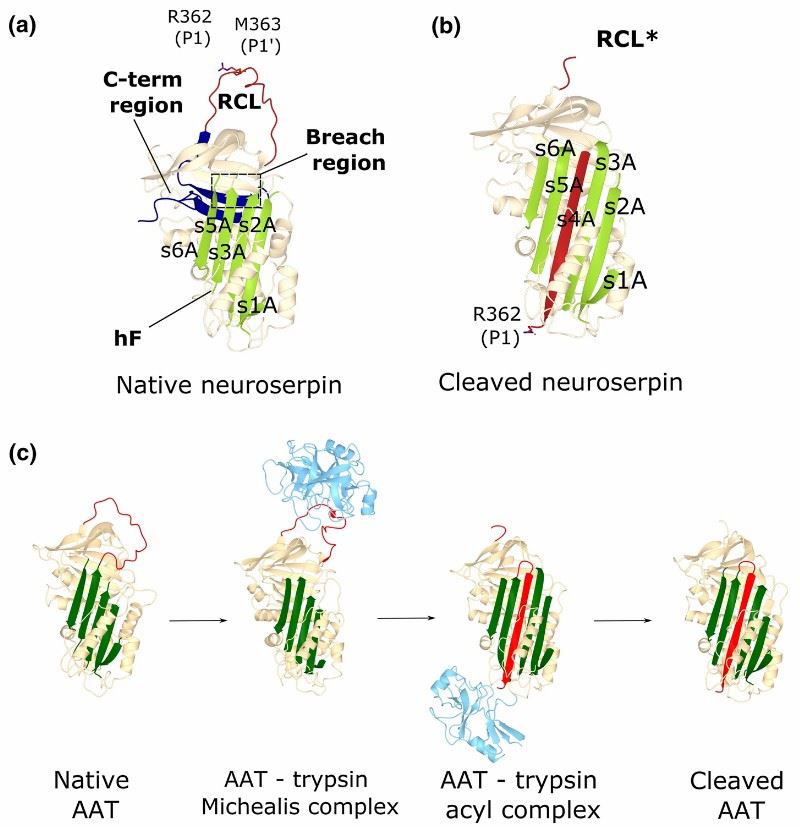What is SERPINI1 Protein
The SERPINI1 protein is a member of the serpin superfamily and plays a key role in regulating cellular processes, particularly in the nervous system.
SERPINI1 (Serpin family I member 1) is a key player in the intricate complex of serine protease inhibitors. This protein has a unique serpin fold, exhibiting a conserved three-dimensional structure that is critical to its inhibitory function. SERPINI1 is mainly expressed in the nervous system, demonstrating its importance in neural processes.
The Structure of SERPINI1
The three-dimensional conformation of SERPINI1 is similar to other serpins, allowing it to interact with serine proteases. This unique structural motif acts as a molecular 'trap,' inhibiting the activity of serine proteases and regulating various cellular processes. This intricate structure emphasizes the precision with which SERPINI1 coordinates proteolytic activity.
 Figure 1. Neuroserpin structures and mechanism of inhibition (D'Acunto, E., et al. 2021)
Figure 1. Neuroserpin structures and mechanism of inhibition (D'Acunto, E., et al. 2021)The Function of SERPINI1 Protein
The main function of SERPINI1 is to regulate serine proteases, which are key enzymes that catalyze the hydrolysis of peptide bonds. By inhibiting these proteases, SERPINI1 helps to precisely control proteolytic activity, preventing excessive protein degradation and maintaining cellular homeostasis. In the nervous system, it affects processes such as neurite growth and synaptic plasticity.
SERPINI1-Related Diseases
Dysregulation of SERPINI1 is associated with multiple neurological diseases, revealing its critical role in maintaining neurological health. Epilepsy is a neurological disorder characterized by recurring seizures. Studies have shown that changes in SERPINI1 expression may affect neuronal excitability, leading to the development of seizures.
Additionally, SERPINI1 has been implicated in neurodegenerative diseases such as Alzheimer's disease and Parkinson's disease. Dysregulation of proteins may lead to abnormal protein aggregation and neuronal damage, further emphasizing their importance in maintaining the structural and functional integrity of the nervous system.
SERPINI1 Related Signaling Pathways
Researchers have delved into complex cell signaling networks to understand how SERPINI1 interacts with various pathways.
- Wnt Signaling Pathway
Regulation of Wnt signaling by SERPINI1 affects processes such as neurite outgrowth and synaptic plasticity, contributing to its role in neural development and maintenance.
- Notch Signaling Pathway
Given the critical role of Notch signaling in cell fate determination and differentiation, the interaction between SERPINI1 and this pathway highlights its involvement in the precise orchestration of cellular processes during development and in adulthood.
Applications of SERPINI1 in Biomedical Research
The unique properties of SERPINI1 make it a promising candidate for biomedical applications. Its role in neural development opens avenues for therapeutic intervention in neurological disorders. Targeting SERPINI1 in drug development may provide a new way to modulate neuroplasticity and mitigate the progression of diseases such as epilepsy, Alzheimer's, and Parkinson's disease.
In addition to treatment, SERPINI1 holds promise as a diagnostic biomarker for certain diseases. Detecting changes in SERPINI1 levels in cerebrospinal fluid or blood samples may provide valuable insights into the underlying pathology of neurological diseases, aiding in early diagnosis and personalized treatment strategies.
From the protein's fundamental role in protease regulation to its impact on neurological diseases, SERPINI1 continues to fascinate researchers. Exploration of its signaling pathways and their applications in biomedicine not only enhances our understanding of cellular processes but also opens new avenues for therapeutic innovation and diagnostic strategies in the evolving field of neurobiology.
Recommended Products for SERPINI1 Protein
| Cat.# | Species | Product name | Source (Host) | Tag |
|---|---|---|---|---|
| SERPINI1-646H | Human | Active Recombinant Human SERPINI1 | E.coli | N/A |
| SERPINI1-8003H | Human | Recombinant Human SERPINI1 protein, His & T7-tagged | E.coli | His/T7 |
| SERPINI1-2345H | Human | Recombinant Human SERPINI1 protein, His-tagged | HEK293 | His |
| SERPINI1-3658H | Human | Recombinant Human SERPINI1 protein, His-tagged | E.coli | His |
| Serpini1-2485M | Mouse | Recombinant Mouse Serpini1, His tagged | Human Cell | His |
| Serpini1-2461M | Mouse | Recombinant Mouse Coagulation Factor X | Insect Cell | His |
| SERPINI1-5347R | Rat | Recombinant Rat SERPINI1 Protein | Mammalian Cell | His |
| SERPINI1-4156R | Rhesus Macaque | Recombinant Rhesus monkey SERPINI1 Protein, His-tagged | Mammalian Cell | His |
| SERPINI1-6982Z | Zebrafish | Recombinant Zebrafish SERPINI1 | Mammalian Cell | His |
| SERPINI1-1229C | Chicken | Recombinant Chicken SERPINI1 | Mammalian Cell | His |
Reference
- D'Acunto, E., et al. Neuroserpin: structure, function, physiology and pathology. Cell Mol Life Sci. 2021, 78(19-20): 6409-6430.

